Bruno Lacerda
Scalable Solution Methods for Dec-POMDPs with Deterministic Dynamics
Aug 29, 2025Abstract:Many high-level multi-agent planning problems, including multi-robot navigation and path planning, can be effectively modeled using deterministic actions and observations. In this work, we focus on such domains and introduce the class of Deterministic Decentralized POMDPs (Det-Dec-POMDPs). This is a subclass of Dec-POMDPs characterized by deterministic transitions and observations conditioned on the state and joint actions. We then propose a practical solver called Iterative Deterministic POMDP Planning (IDPP). This method builds on the classic Joint Equilibrium Search for Policies framework and is specifically optimized to handle large-scale Det-Dec-POMDPs that current Dec-POMDP solvers are unable to address efficiently.
A Finite-State Controller Based Offline Solver for Deterministic POMDPs
May 01, 2025



Abstract:Deterministic partially observable Markov decision processes (DetPOMDPs) often arise in planning problems where the agent is uncertain about its environmental state but can act and observe deterministically. In this paper, we propose DetMCVI, an adaptation of the Monte Carlo Value Iteration (MCVI) algorithm for DetPOMDPs, which builds policies in the form of finite-state controllers (FSCs). DetMCVI solves large problems with a high success rate, outperforming existing baselines for DetPOMDPs. We also verify the performance of the algorithm in a real-world mobile robot forest mapping scenario.
Return Capping: Sample-Efficient CVaR Policy Gradient Optimisation
Apr 29, 2025Abstract:When optimising for conditional value at risk (CVaR) using policy gradients (PG), current methods rely on discarding a large proportion of trajectories, resulting in poor sample efficiency. We propose a reformulation of the CVaR optimisation problem by capping the total return of trajectories used in training, rather than simply discarding them, and show that this is equivalent to the original problem if the cap is set appropriately. We show, with empirical results in an number of environments, that this reformulation of the problem results in consistently improved performance compared to baselines.
No Regrets: Investigating and Improving Regret Approximations for Curriculum Discovery
Aug 27, 2024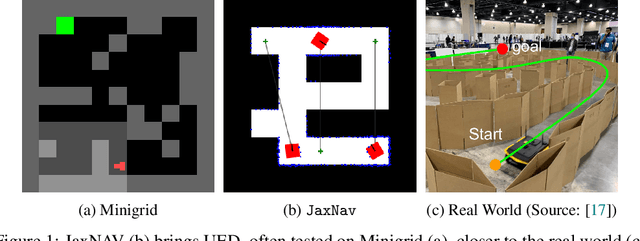
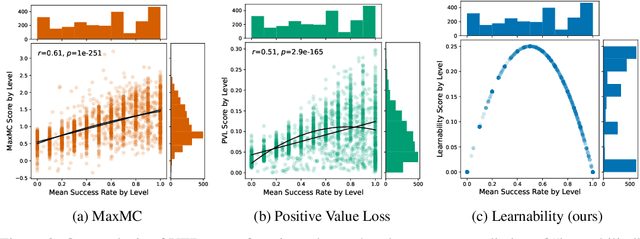
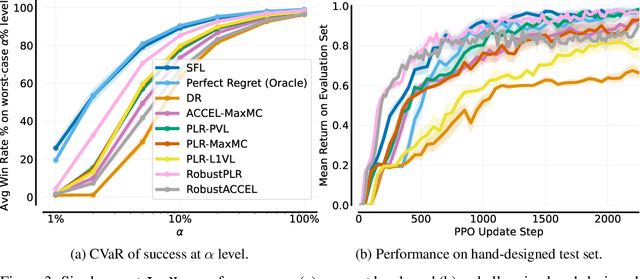
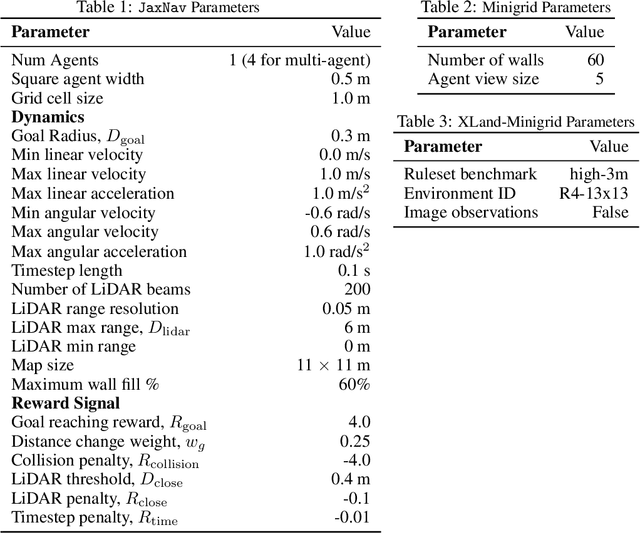
Abstract:What data or environments to use for training to improve downstream performance is a longstanding and very topical question in reinforcement learning. In particular, Unsupervised Environment Design (UED) methods have gained recent attention as their adaptive curricula enable agents to be robust to in- and out-of-distribution tasks. We ask to what extent these methods are themselves robust when applied to a novel setting, closely inspired by a real-world robotics problem. Surprisingly, we find that the state-of-the-art UED methods either do not improve upon the na\"{i}ve baseline of Domain Randomisation (DR), or require substantial hyperparameter tuning to do so. Our analysis shows that this is due to their underlying scoring functions failing to predict intuitive measures of ``learnability'', i.e., in finding the settings that the agent sometimes solves, but not always. Based on this, we instead directly train on levels with high learnability and find that this simple and intuitive approach outperforms UED methods and DR in several binary-outcome environments, including on our domain and the standard UED domain of Minigrid. We further introduce a new adversarial evaluation procedure for directly measuring robustness, closely mirroring the conditional value at risk (CVaR). We open-source all our code and present visualisations of final policies here: https://github.com/amacrutherford/sampling-for-learnability.
Monte Carlo Tree Search with Boltzmann Exploration
Apr 11, 2024Abstract:Monte-Carlo Tree Search (MCTS) methods, such as Upper Confidence Bound applied to Trees (UCT), are instrumental to automated planning techniques. However, UCT can be slow to explore an optimal action when it initially appears inferior to other actions. Maximum ENtropy Tree-Search (MENTS) incorporates the maximum entropy principle into an MCTS approach, utilising Boltzmann policies to sample actions, naturally encouraging more exploration. In this paper, we highlight a major limitation of MENTS: optimal actions for the maximum entropy objective do not necessarily correspond to optimal actions for the original objective. We introduce two algorithms, Boltzmann Tree Search (BTS) and Decaying ENtropy Tree-Search (DENTS), that address these limitations and preserve the benefits of Boltzmann policies, such as allowing actions to be sampled faster by using the Alias method. Our empirical analysis shows that our algorithms show consistent high performance across several benchmark domains, including the game of Go.
* Camera ready version of NeurIPS2023 paper
JaxMARL: Multi-Agent RL Environments in JAX
Nov 20, 2023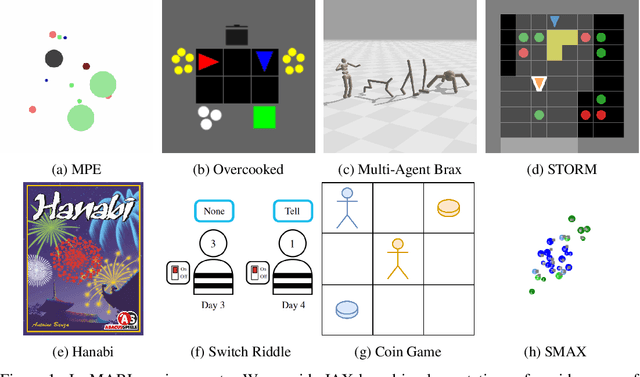

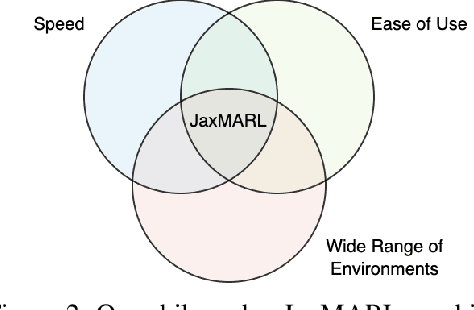

Abstract:Benchmarks play an important role in the development of machine learning algorithms. For example, research in reinforcement learning (RL) has been heavily influenced by available environments and benchmarks. However, RL environments are traditionally run on the CPU, limiting their scalability with typical academic compute. Recent advancements in JAX have enabled the wider use of hardware acceleration to overcome these computational hurdles, enabling massively parallel RL training pipelines and environments. This is particularly useful for multi-agent reinforcement learning (MARL) research. First of all, multiple agents must be considered at each environment step, adding computational burden, and secondly, the sample complexity is increased due to non-stationarity, decentralised partial observability, or other MARL challenges. In this paper, we present JaxMARL, the first open-source code base that combines ease-of-use with GPU enabled efficiency, and supports a large number of commonly used MARL environments as well as popular baseline algorithms. When considering wall clock time, our experiments show that per-run our JAX-based training pipeline is up to 12500x faster than existing approaches. This enables efficient and thorough evaluations, with the potential to alleviate the evaluation crisis of the field. We also introduce and benchmark SMAX, a vectorised, simplified version of the popular StarCraft Multi-Agent Challenge, which removes the need to run the StarCraft II game engine. This not only enables GPU acceleration, but also provides a more flexible MARL environment, unlocking the potential for self-play, meta-learning, and other future applications in MARL. We provide code at https://github.com/flairox/jaxmarl.
A Framework for Learning from Demonstration with Minimal Human Effort
Jun 15, 2023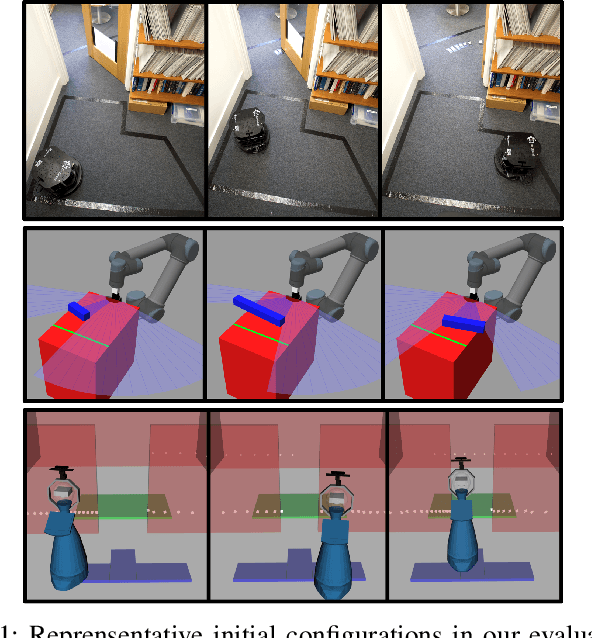
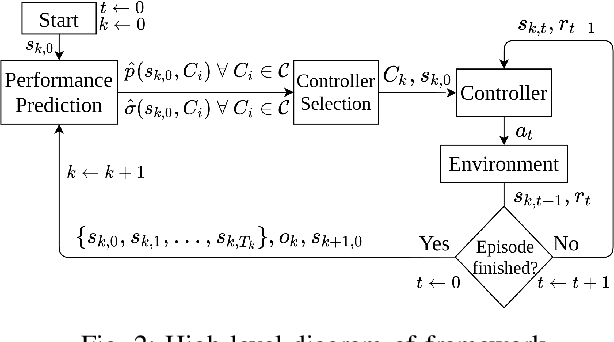
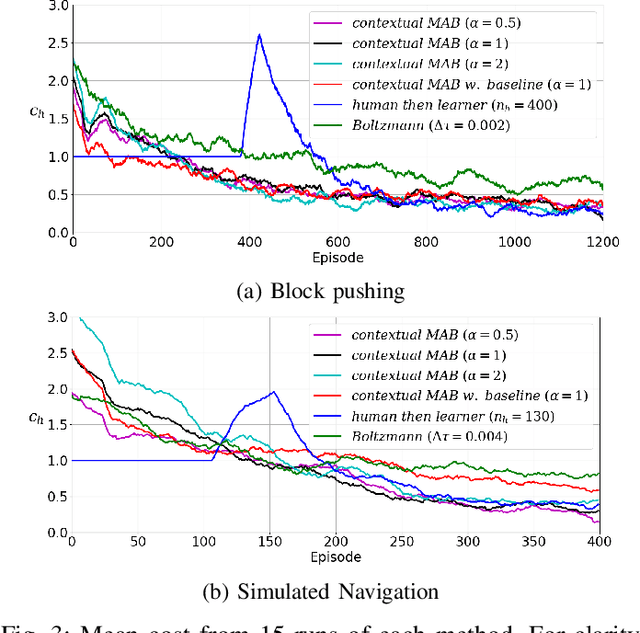
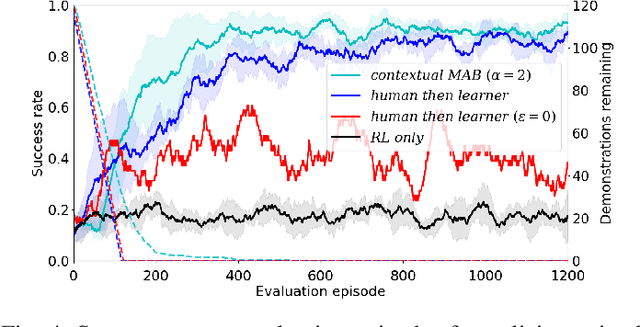
Abstract:We consider robot learning in the context of shared autonomy, where control of the system can switch between a human teleoperator and autonomous control. In this setting we address reinforcement learning, and learning from demonstration, where there is a cost associated with human time. This cost represents the human time required to teleoperate the robot, or recover the robot from failures. For each episode, the agent must choose between requesting human teleoperation, or using one of its autonomous controllers. In our approach, we learn to predict the success probability for each controller, given the initial state of an episode. This is used in a contextual multi-armed bandit algorithm to choose the controller for the episode. A controller is learnt online from demonstrations and reinforcement learning so that autonomous performance improves, and the system becomes less reliant on the teleoperator with more experience. We show that our approach to controller selection reduces the human cost to perform two simulated tasks and a single real-world task.
Formal Modelling for Multi-Robot Systems Under Uncertainty
May 26, 2023Abstract:Purpose of Review: To effectively synthesise and analyse multi-robot behaviour, we require formal task-level models which accurately capture multi-robot execution. In this paper, we review modelling formalisms for multi-robot systems under uncertainty, and discuss how they can be used for planning, reinforcement learning, model checking, and simulation. Recent Findings: Recent work has investigated models which more accurately capture multi-robot execution by considering different forms of uncertainty, such as temporal uncertainty and partial observability, and modelling the effects of robot interactions on action execution. Other strands of work have presented approaches for reducing the size of multi-robot models to admit more efficient solution methods. This can be achieved by decoupling the robots under independence assumptions, or reasoning over higher level macro actions. Summary: Existing multi-robot models demonstrate a trade off between accurately capturing robot dependencies and uncertainty, and being small enough to tractably solve real world problems. Therefore, future research should exploit realistic assumptions over multi-robot behaviour to develop smaller models which retain accurate representations of uncertainty and robot interactions; and exploit the structure of multi-robot problems, such as factored state spaces, to develop scalable solution methods.
One Risk to Rule Them All: A Risk-Sensitive Perspective on Model-Based Offline Reinforcement Learning
Nov 30, 2022



Abstract:Offline reinforcement learning (RL) is suitable for safety-critical domains where online exploration is too costly or dangerous. In safety-critical settings, decision-making should take into consideration the risk of catastrophic outcomes. In other words, decision-making should be risk-sensitive. Previous works on risk in offline RL combine together offline RL techniques, to avoid distributional shift, with risk-sensitive RL algorithms, to achieve risk-sensitivity. In this work, we propose risk-sensitivity as a mechanism to jointly address both of these issues. Our model-based approach is risk-averse to both epistemic and aleatoric uncertainty. Risk-aversion to epistemic uncertainty prevents distributional shift, as areas not covered by the dataset have high epistemic uncertainty. Risk-aversion to aleatoric uncertainty discourages actions that may result in poor outcomes due to environment stochasticity. Our experiments show that our algorithm achieves competitive performance on deterministic benchmarks, and outperforms existing approaches for risk-sensitive objectives in stochastic domains.
RAMBO-RL: Robust Adversarial Model-Based Offline Reinforcement Learning
Apr 26, 2022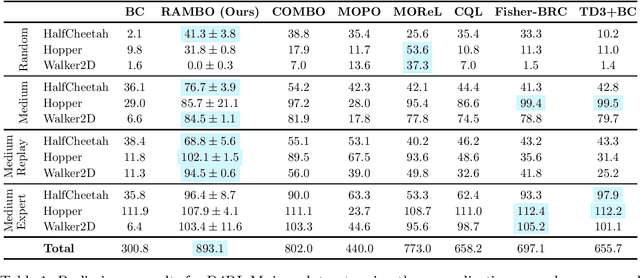
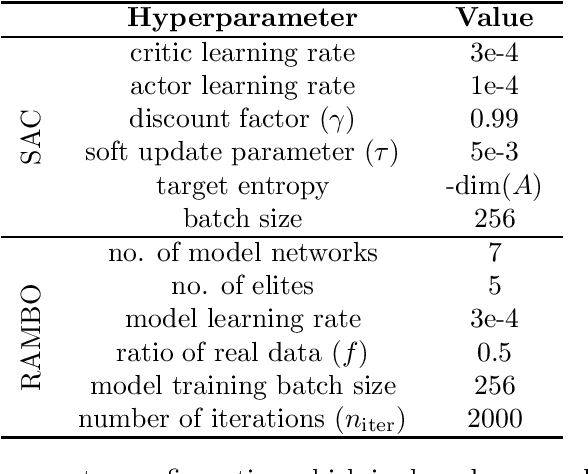
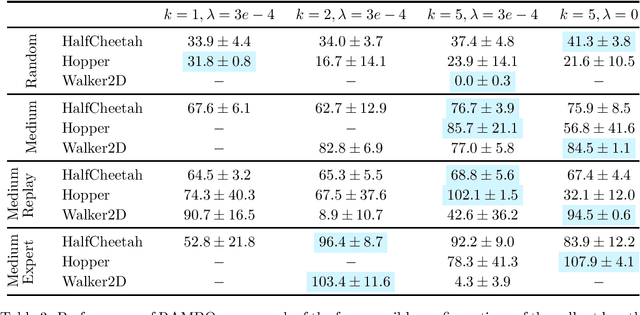
Abstract:Offline reinforcement learning (RL) aims to find near-optimal policies from logged data without further environment interaction. Model-based algorithms, which learn a model of the environment from the dataset and perform conservative policy optimisation within that model, have emerged as a promising approach to this problem. In this work, we present Robust Adversarial Model-Based Offline RL (RAMBO), a novel approach to model-based offline RL. To achieve conservatism, we formulate the problem as a two-player zero sum game against an adversarial environment model. The model is trained minimise the value function while still accurately predicting the transitions in the dataset, forcing the policy to act conservatively in areas not covered by the dataset. To approximately solve the two-player game, we alternate between optimising the policy and optimising the model adversarially. The problem formulation that we address is theoretically grounded, resulting in a PAC performance guarantee and a pessimistic value function which lower bounds the value function in the true environment. We evaluate our approach on widely studied offline RL benchmarks, and demonstrate that our approach achieves state of the art performance.
 Add to Chrome
Add to Chrome Add to Firefox
Add to Firefox Add to Edge
Add to Edge